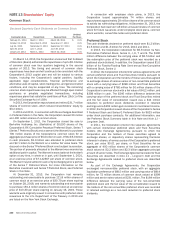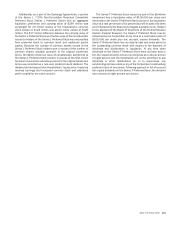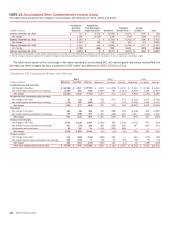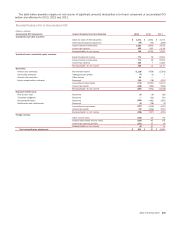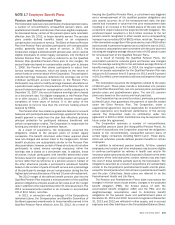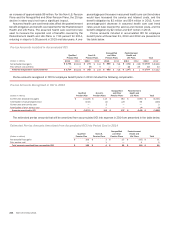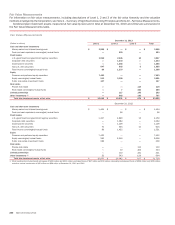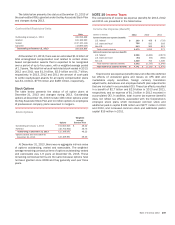Bank of America 2013 Annual Report Download - page 241
Download and view the complete annual report
Please find page 241 of the 2013 Bank of America annual report below. You can navigate through the pages in the report by either clicking on the pages listed below, or by using the keyword search tool below to find specific information within the annual report.Bank of America 2013 239
capitalization, with no mandatory actions required for “well-
capitalized” banking entities.
In November 2011, the Basel Committee on Banking
Supervision (Basel Committee) published a methodology to
identify global systematically important banks (G-SIBs) and impose
an additional loss absorbency requirement through the
introduction of a buffer of up to 3.5 percent for systemically
important financial institutions (SIFIs). The assessment
methodology relies on an indicator-based measurement approach
to determine a score relative to the global banking industry. The
chosen indicators are size, complexity, cross-jurisdictional activity,
interconnectedness and substitutability/financial institution
infrastructure. Institutions with the highest scores are designated
as G-SIBs and are assigned to one of four loss absorbency buckets
from one percent to 2.5 percent, in 0.5 percent increments based
on each institution’s relative score and supervisory judgment. The
fifth loss absorbency bucket of 3.5 percent is currently empty and
serves to discourage banks from becoming more systemically
important.
In July 2013, the Basel Committee updated the November
2011 methodology to recalibrate the substitutability/financial
institution infrastructure indicator by introducing a cap on the
weighting of that component, and require the annual publication
by the Financial Stability Board (FSB) of key information necessary
to permit each G-SIB to calculate its score and observe its position
within the buckets and relative to the industry total for each
indicator. Every three years, beginning on January 1, 2016, the
Basel Committee will reconsider and recalibrate the bucket
thresholds. The Basel Committee and FSB expect banks to change
their behavior in response to the incentives of the G-SIB framework,
as well as other aspects of Basel 3 and jurisdiction-specific
regulations.
The SIFI buffer requirement will begin to phase in effective
January 2016, with full implementation in January 2019. Data
from 2013, measured as of December 31, 2013, will be used to
determine the SIFI buffer that will be effective for the Corporation
in 2016. U.S. banking regulators have not yet issued proposed or
final rules related to the SIFI buffer or disclosure requirements.
Regulatory Capital Transitions
Important differences in determining the composition of regulatory
capital between Basel 1 – 2013 Rules and Basel 3 include changes
in capital deductions related to MSRs, deferred tax assets and
defined benefit pension assets, and the inclusion of unrealized
gains and losses on AFS debt and certain marketable equity
securities recorded in accumulated OCI, each of which will be
impacted by future changes in interest rates, overall earnings
performance or other corporate actions.
Changes to the composition of regulatory capital under Basel
3, such as recognizing the impact of unrealized gains or losses
on AFS debt securities in Tier 1 common capital, are subject to a
transition period where the impact is recognized in 20 percent
annual increments. These regulatory capital adjustments and
deductions will be fully implemented in 2018. The phase-in period
for the new minimum capital ratio requirements and related buffers
under Basel 3 is from January 1, 2014 through December 31,
2018. When presented on a fully phased-in basis, capital, risk-
weighted assets and the capital ratios assume all regulatory
capital adjustments and deductions are fully recognized.
In addition, Basel 3 revised the regulatory capital treatment
for Trust Securities, requiring them to be partially transitioned from
Tier 1 capital into Tier 2 capital in 2014 and 2015, until fully
excluded from Tier 1 capital in 2016, and partially transitioned
and excluded from Tier 2 capital beginning in 2016. The exclusion
from Tier 2 capital starts at 40 percent on January 1, 2016,
increasing 10 percent each year until the full amount is excluded
from Tier 2 capital beginning on January 1, 2022.
Standardized Approach
The Basel 3 Standardized approach measures risk-weighted
assets primarily for market risk and credit risk exposures.
Exposures subject to market risk, as defined under the rules, are
measured on the same basis as the Market Risk Final Rule,
described previously. Credit risk exposures are measured by
applying fixed risk weights to the exposure, determined based on
the characteristics of the exposure, such as type of obligor,
Organization for Economic Cooperation and Development (OECD)
country risk code and maturity, among others. Under the
Standardized approach, no distinction is made for variations in
credit quality for corporate exposures, and the economic benefit
of collateral is restricted to a limited list of eligible securities and
cash. Some key differences between the Standardized and
Advanced approaches are that the Advanced approach includes a
measure of operational risk and a credit valuation adjustment
capital charge in credit risk and relies on internal analytical models
to measure credit risk-weighted assets, as more fully described
below.
Advanced Approach
Under the Basel 3 Advanced approach, risk-weighted assets are
determined primarily for market risk, credit risk and operational
risk. Market risk capital measurements are consistent with the
Standardized approach, except for securitization exposures, where
the Supervisory Formula Approach is also permitted, and certain
differences arising from the inclusion of the CVA capital charge in
the credit risk capital measurement. Credit risk exposures are
measured using advanced internal ratings-based models to
determine the applicable risk weight by estimating the probability
of default, LGD and, in certain instances, exposure at default. The
analytical models primarily rely on internal historical default and
loss experience. Operational risk is measured using advanced
internal models which rely on both internal and external operational
loss experience and data. The Basel 3 Advanced approach requires
approval by the U.S. regulatory agencies of the Corporation’s
internal analytical models used to calculate risk-weighted assets.
Supplementary Leverage Ratio
Basel 3 also will require the Corporation to calculate a
supplementary leverage ratio, determined by dividing Tier 1 capital
by total leverage exposure for each month-end during a fiscal
quarter, and then calculating the simple average. Total leverage
exposure is comprised of all on-balance sheet assets, plus a
measure of certain off-balance sheet exposures, including, among
others, lending commitments, letters of credit, over-the-counter
(OTC) derivatives, repo-style transactions and margin loan
commitments. The minimum supplementary leverage ratio
requirement of three percent is not effective until January 1, 2018.
The Corporation will be required to disclose its supplementary
leverage ratio effective January 1, 2015.



